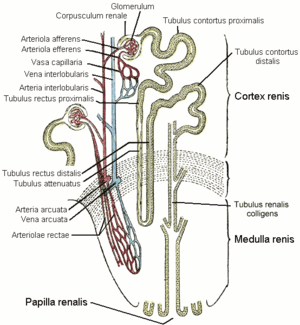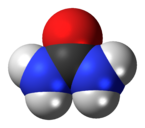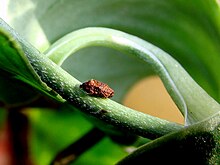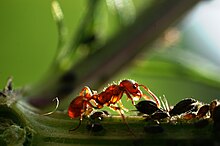excretion

C blood circulation (or lymph), D digestive tract , E excretion opening, N nervous system , R breathing
As excretion ( Latin excernere "retire") issue is superfluous metabolic products from the body referred to the environment. The process is often simply called excretion , but it also includes secretion and all other discharges of the body. Excretion includes the release of dissolved components, the defecation of solid components, and the release of gaseous components that the body no longer needs.
Defecation is the release of indigestible components of food that remain inside the intestine and have not been absorbed into the body (e.g. indigestible fiber ), as well as undesirable or superfluous metabolic substances that can be released to the intestine for excretion. In many animals , they are released through a sewer . In addition, respiration , urinary organs and skin are involved in excretion in vertebrates . The release of respiratory gases ( carbon dioxide ) and water vapor is mostly counted for breathing and not for excretion. The volume of gas excreted rectally ( meteorism , flatulence ) is assigned to excretion.
In the case of organisms that release solid and dissolved components separately (via the anus and urinary organ) (many mammals including humans ), excretion can only be related to the release in aqueous form via the urethra . The collective name for products of excretion in dissolved form and defecation is excrement .
In the case of plants, too, can be described as excretion when metabolic products harmful to the organism are excreted. Often this happens through special excretion or secretion tissues.
Excreted substances
The excretion includes degradation products of the metabolism , salts or their ions and undigested components, usually perceived as solids. It also contains a greater or lesser amount of water.
Accompanying substances
water
As a rule, water is not a substance that has to be given off. On the contrary, all organisms need water in order to be able to carry out vital functions. In the excretions, however, water is largely indispensable in order to conduct water-soluble substances (in medicine this is also referred to as " urinary substances") from the body. But digestive residues can still bind considerable amounts of water, human feces contain around 40% of the volume of water excreted. In fact, water can make up most of the excretions. It is precisely the available water content that is characteristic of the various excretion systems developed in evolution . It is hardly limited in aquatic organisms. Nevertheless, the solution paths of the aquatic organisms sometimes differ considerably, they build on the approaches of their ancestors, some of which were not aquatic organisms. In terrestrial organisms there is not enough water available, so on the one hand mechanisms are required that require small amounts of water, and on the other hand water recovery (water absorption) becomes important. The primary urine is concentrated in the tubular system ( kidney tubules ) of the nephron in the kidneys of mammals, that is, water is recovered. In the case of flying organisms, the amount of water available becomes even more critical, because the amounts of water required for excretion purposes contribute to the mass of the organism. Effective weight reduction therefore also means that the excretion mechanism requires as little water as possible.
The situation is different only for organisms that ingest large amounts of water with their food. These do not include the large plankton eater ( basking shark , whale shark , blue whale ), which do not swallow the water at all, but release or squeeze it out through filters (gill slits or beards). Organisms that regularly ingest large amounts of water with their food are mainly blood-eating ectoparasites . Water ballast is a challenge, especially for airmen, because the blood uptake can exceed their actual body weight and greatly impair their ability to fly. This not only applies to blood-sucking insects , vampire bats , for example, are also affected. Therefore, after the blood meal is diuresis hormonally strongly encouraged to much of the amount of water rapidly excrete much.
Lubricants
In addition to the main component water, slimy lubricants from the intestinal mucosa or glands are often included in the excreta, faeces and excrement to facilitate intestinal passage and elimination .
Degradation products
Decomposition products of the metabolism that are no longer needed must be released into the environment. Sometimes these metabolites are toxic to other organisms as well as the donor organism . This affects all organisms, all kingdoms . A failure of the urinary organ can lead to urinary poisoning , for example .
Nitrogen compounds
A central task of animal excretion is to remove excess nitrogen compounds from the body. All animals feed on other organisms or their leftovers and use the chemical energy stored in their components or convert the substances they have absorbed into the body's own substances ( metabolism ). However, there is less need for the nitrogenous components (mainly from protein and nucleic acid breakdown ). The excess must be excreted. Since this cannot be converted into the form of gaseous nitrogen, other approaches are being pursued. The choice of nitrogen carrier and the design of the excretion system depend on the ambient conditions, in particular the water supply. Aquatic organisms preferentially release ammonium as a nitrogen carrier, while land-living animals mostly excrete urea or uric acid. Ammonium, urea and uric acid are transported through cell membranes via different mechanisms, according to their chemical behavior in solution.
Water requirement when excreting 1 g of nitrogen:
- Ammonia solution: 500 ml of water
- Urea: 50 ml of water
- Uric acid: 1 ml of water
Plants have less of a problem with nitrogen enrichment; they generally lack organic nitrogen compounds.
ammonia
Ammonia is a possible and easy to implement nitrogen compound and also has the advantage of hardly containing any chemical energy. The substance is toxic to organisms even in small quantities, e.g. B. pungent smelling for people. It is a gas that is readily soluble in water, but when dissolved it requires a very high dilution in order not to be toxic during excretion. It is therefore particularly suitable for dispensing using gills . In most bony fish and the larvae of many amphibians , nitrogen compounds are excreted for the most part as ammonia directly from the blood through the gills, a kidney is unnecessary.
ammonium
Similar to ammonia, ammonium can also be released directly from the blood into the surrounding water through the gills of many fish.
Small birds like hummingbirds in particular have developed another possibility , they excrete nitrogen mainly as ammonium in a water-poor form (as a paste). But mammals and humans also give off ammonium with their urine.
urea
Water-soluble urea and its excretion as urine is advantageous because it contains little chemically bound energy, but has the disadvantage that it can only be excreted in water. The nitrogen carrier urea is excreted primarily in their urine by most mammals, around 20% with the faeces. For flying animals such as bats, urea excretion is less of a consideration because of the water binding.
When the released urea is broken down, ammonia can develop from it through hydrolysis .
Bony fish can also be able to release urea and, depending on the conditions, choose between different nitrogen carriers. These include anabas ( Anabas Scandens ), shield fish ( sicyases sanguineus ), snakehead ( Channa Gachua Channa gachua ) Blennies ( Blennius pholis ), Stachel catfish ( Mystus vittatus ) and others who are amphibian in the intertidal zone. As long as they are surrounded by enough water, like most fish, they release nitrogen mainly through their gills in the form of ammonia. When they are no longer in the water, they usually release urea through their mucous membranes. This urea in turn contributes to the moisture retention by binding air humidity. The release of ammonia via the gills is not possible in air; the release of ammonia via the mucous membranes would not be opportune because of the adhesion of the poison.
Guanine
The excretion of guanine as a nitrogen carrier is disadvantageous because it is more energetic than urea, but it has the great advantage for flight animals that its excretion hardly requires any water, so it also requires less ballast (the energy balance is positive). Guanine excretion is not very common, but most birds and bats excrete guanine (mixed with uric acid) as pasty excreta, this also applies to flightless birds such as penguins, but not ostriches . Weathering results in guano or bat guano .
uric acid
Uric acid is excreted by many insects, reptiles, and birds. Many mammals and humans also give off uric acid, around 65% with their urine and around 35% with their faeces.
Creatinine / creatine
Creatinine or creatine is also excreted as a nitrogen carrier, but often only seen as the body's own protein breakdown product . It comes mainly from muscle breakdown.
Many mammals and humans excrete the urinary metabolic product creatinine in the urine. Creatinine clearance is often used to assess kidney function, as this process characterizes kidney performance particularly well. Instead, birds mainly excrete creatine in their pasty excreta.
Keto body
Healthy people can occasionally, sick people ( diabetes mellitus , ketonemia) excrete keto bodies ( acetoacetic acid and beta- hydroxybutyric acid ) or acetone , mainly in the urine (known as ketonuria ), and sometimes also in the respiratory gases. Keto bodies are breakdown products.
Digestive gases
In many animals and humans, digestion also produces gaseous components that are released rectally (0.5–1.5 liters per day), known as flatulence. Five different gases in very variable amounts make up 99% of intestinal gas production in humans:
| gas | formula | proportion of |
|---|---|---|
| nitrogen | N 2 | 11-92% |
| oxygen | O 2 | 0-11% |
| Carbon dioxide | CO 2 | 3–54% |
| Steam | H 2 O | 0-86% |
| methane | CH 4 | 0-56% |
Large differences arise from different diets or illnesses (such as irritable bowel syndrome ). Many of these gas components arise primarily as breathing gases of the endosymbionts , often to a considerable extent in cellulose- digesting animals such as ruminants , which cannot produce cellulases themselves . The ratio of the gases to one another can also change.
In addition, faeces and excrement can contain many volatile substances such as indole , skatole , alkanethiols and hydrogen sulfide , which many animals can perceive with their sense of smell, either to avoid them or to use them as food .
Salts
For osmoregulation and other physiological processes, it is necessary to control salt concentrations in the body through selective excretion. This need also applies to plants.
The urinary organ offers a possibility of excreting salts or their ions (especially sodium ions and chloride ions, which are usually the most common) for osmoregulation . This excretion process requires a high water turnover, so organisms that do not live in the water cannot excrete large amounts of salt. Corresponding to the function of the urinary organ, the excretion of salts in many invertebrates can take place via nephridia . Other options are excretion through the skin (for example as sweat ), but there are a large number of animals, especially those that are flying. An exoskeleton (in arthropods ) also stands in the way of this. Many land animals are therefore incapable of excreting sweat. Salt is dispensed through the gills almost without any problems.
The osmoregulation and salt excretion of marine mammals does not seem to differ significantly from that of land-based mammals. Presumably they hardly take in sea water, but cover their water needs from their food, which only contains about half the salt concentration of sea water.
In the case of delivery via the urinary organ, the involvement of a kidney is required for the salt release.
Undigested
Undigested and indigestible components of food mostly pass through the intestines for defecation. This also includes the light-colored, lime-rich solid excretions of hyenas or other predators , which consist of remains of the ingested bones. Some solids are regularly released or regurgitated via the intake route, generally in cnidarians (Cnidaria) or many birds ( hornbills ), but (at least occasionally) in all animals with a mouth ( vomiting , bulging ). However, this process is seldom attributed to excretion.
Elimination forms
There are many forms of excretion, in addition to which the release via the gills and solid, lime-rich excrement of some predators represent the two extreme opposites. In between there are liquid and pasty excretions. In many cases, excretions are also inhomogeneous mixed forms, compositions of different consistencies with delimitable materially different areas.
urine
In many animals , water-soluble substances are filtered out of the blood by the kidneys and released through the urine (renal excretion), in particular urea and uric acid dissolved in water, e.g. B. in monkeys and humans. In reptiles, the proportion of uric acid is greater; in them it also contains the nitrogen from amino acid breakdown . Even insects excrete in their urine urea.
Feces
The liver releases some of the degradation products into the intestine via the bile (biliary excretion). There they are, together with the intestine's own excretions, becoming part of the faeces .
Guanine
The excrement of most birds, reptiles and bats contains the pasty guanine as an excretion form of nitrogen.
Monotremes
Animals with a cloaca excrete uric acid or the products of the kidneys and the intestinal feces together via the cloaca opening.
Sweat
In humans and many mammals, sweating is primarily used for temperature regulation and intra-species chemocommunication. If only these processes are considered, sweat production is usually not assigned to excretion. However, insofar as the osmoregulation is affected and, for example, sodium, potassium, calcium or magnesium ions are specifically channeled out of the body through sweat, the sweat counts as excretion. It is also considered an excretion performance that the urea concentration in human sweat exceeds that in human urine. Sweat also serves as a path of elimination for more complex metabolic substances and medicinal substances that are harmful to the liver.
Organ systems
Central metabolic organ
A central metabolic organ such as the liver in many vertebrates is often responsible for converting substances into a form that enables excretion. They can then be released enterohepatically and via the intestine.
Body surface
All dissolved substances can be released through the skin, provided there is enough water and a permeable body surface. The skin excretion is therefore particularly unproblematic for aquatic animals with a soft surface. In the case of small organisms without skin ( single cells ), excretion takes place even more easily via the cell membrane as exocytosis or by expulsion of a cell component (as in the expulsion of organelles and cell nucleus when the erythroblasts mature into erythrocytes ).
In the case of skin excretion and excretion via the cell membranes, the functions of excretion, secretion and respiration can hardly be defined.
breathing
In addition to carbon dioxide , the release of which is attributed to respiration rather than excretion, the respiratory system in particular releases ammonia or ammonium via the gills of many aquatic animals, such as marine bony fish . Many marine bony fish also control their osmoregulation and salt release via their gills.
Urinary excretion
Urine formation serves to excrete water-soluble substances, i.e. uric acid, urea and many breakdown products.
In many invertebrates , various forms of nephridia take over the excretion; Protonephridia in flatworms (Plathelminthes) and many larvae of the Spiralia and metanephridia in annelids (Annelida) and other animals with a coelom . The urinary organ consists of the kidneys , ureters , bladder and urethra . This organ system is fully developed in many mammals, in many other vertebrates only partially, in birds there is no bladder and an external ureter opening (except in ostriches ). A urinary organ does not have to exist even in species if their excretion takes place via other organs, for example in the case of endoparasites via their skin.
The main job of the kidney is to recover water from the primary urine. This is the process in which most of the energy that the kidneys work goes into.
Rectal excretion
In insects , the metabolic waste is excreted by means of a system of Malpighian vessels . The substances to be excreted diffuse or are actively transported into the vessels, from where they are conducted into the rectum. Water and ions are then withdrawn there. The remaining excretions are then excreted along with the feces.
In mammals and other vertebrates, degradation products produced in the liver are excreted via the bile (enterohepatic) and rectally via the intestine.
Gaseous substances can leave the digestive tract rectally and orally. Often no importance is attached to this form of excretion, but the release of methane by ruminants is a factor to be taken seriously in the calculation of greenhouse gases . Flatulence is not attributable to respiration (except for that of the archaea in the ruminant stomach ).
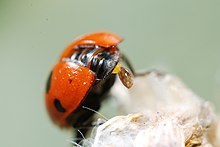
Sewer
Most terrestrial vertebrates have a single body opening ( cloaca ) for excretion. Even if separate outlets for solid and liquid components open here, water and salts can be reabsorbed in the cloaca and thus achieve a lower salt and water loss for the total excretion. Birds give off their pasty excreta through their sewer.
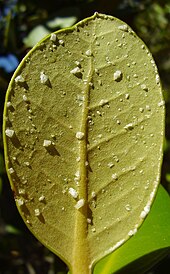
Special glands
Some crustaceans excrete via antenna glands , some arachnids via coxal glands . Cartilaginous fish, many marine reptiles (such as sea turtles and sea snakes) and sea birds have salt glands for osmoregulation. Plants also have organs of salt excretion.
Secondary functions
Excretion products are occasionally used for additional functions.
Additional benefit
Osmoregulation and acid-base regulation
Excretion of ions usually also means osmoregulation and often also regulation of the acid-base balance. This affects salt excretion, the excretion of some nitrogen carriers and the excretion of other charged metabolites. Not all nitrogen carriers are in charged form, but both invertebrates and vertebrates have different nitrogen carriers for cellular osmoregulation. The ammonium excretion of vertebrates via the kidneys and the ammonium metabolism are linked to the renal acid-base regulation.
Buoyancy aid
The excretion of gases, including nitrogen carriers, also serves to create buoyancy in some aquatic animals. Not all nitrogen carriers are suitable for this, but ammonium is preferred. Gaseous ammonia is also unsuitable for filling a float because of its toxic properties. The release via the gills also stands in the way of use as a buoyancy aid. Mainly aquatic invertebrates can use gaseous ammonium as a buoyancy aid.
Thermoregulation
The main function of sweat excretion is a temperature-lowering thermoregulation in some capable mammals and in humans. To optimize it, the sweat contains particularly high urea concentrations, which ensure that additional humidity is bound to the skin and thus significantly extend the performance of the evaporative cooling.
communication
Excreta, faeces and excrement are often used to demarcate territory in animals that form territories and can then contain additional marker substances from anal glands .
Excrete mate-seeking animals sometimes contain attractants to attract potential mates. Some female animals excrete substances with their excreta that indicate to their male counterparts that they are ready to mate. Some males use the individuality of their odorous substances in their excreta to keep rival males away.
Some animals use the odor composition of their excreta (but also secretions of special glands) to identify each other individually or as members of a community, especially those living in widely branched burrows. Often this requires that they massage themselves with their excreta.
The excreta of sweat often contain pheromones that help determine the attractiveness of the choice of partner, but also factors that allow an individual identification of pack members. However, not all mammals share this anatomical possibility with humans.
Repellants
Some animals are able to spray their excrement or excrement in a targeted manner to ward off predators , but this is often a special secretion from stinking glands that is not considered excretion.
Benefit to other organisms

Food source
Excretory products usually contain a variety of substances in which chemical energy is bound and whose breakdown is worthwhile for specialized organisms: faeces (such as the holy pill-topper ) and many of the organisms living in dead organic matter ( saprobionts and saprophages such as many blowflies or their maggots) . Even honey bees occasionally take of cattle lice excreted honeydew from spruce up. After all, their processed product is also willingly enjoyed by people in the forest honey . The triple sugar melezitose found in it attests to its origin in the tree sap.
Some rodents ( guinea pigs ), rabbits and some horse relatives often take their excretions again in order to utilize them better in a second intestinal passage, analogous to ruminants, which are capable of intensive use of their feed materials without having to ingest their excretions. The process of eating one's own excrement is called autocoprophagy .
Some animals have specialized in living symbiotically together, with the excretions of one type of food being the food of the other. Known for this are aphids and scale insects , which are cared for by ants in order to ingest their deposited honeydew .
Spread
Many endoparasites use the excretion route to change host or to spread . Excreta are generally loaded with harmless and also pathogenic viruses , bacteria , fungal spores and parasites . This route of infection poses a serious hygiene problem.
Plants use carryover in the digestive system of animals and excretion of their seeds as a spreading strategy . To ensure this, they often invest in the attractiveness of fruit. This process is commonly called endochory , referred to as bird ornithochory .
orientation
It has been suggested that rodents can use the odor perception of excrement from particularly threatening predators to avoid such areas. This assumption has been refuted in an example. Conversely, however, some predators prefer certain hunting areas due to the smell of excrement from their prey.
Vandelliinae such as Vandellia cirrhosa (from the loach catfish family in the Amazon basin ) swim into the gill openings of larger fish, penetrate the gill aorta, perforate it with their pointed teeth and absorb the blood that is escaping without sucking. To identify the victim, Vandelliinae use the perception of their excretion and pursue them, following the concentration. Due to confusion, they occasionally penetrate the human urethra (which requires surgical removal), which is why they are also known as urethral catfish or penile fish.
imitation
Visually
To protect themselves from predators to camouflage , some insect larvae mimic bird droppings. This strategy of mimicking dead objects is called allomimesis .
Smell
Some organisms produce odorous substances that mimic those often found in excretions in order to attract coprophages and saprophages olfactory . This is the case with some mushrooms and a few plants , which mainly attract flies and mosquitoes ( two-winged birds ). This is done for different purposes: For example, stinkhorns lure with them to encourage the spread of their spores , some arum plants lure them to achieve fertilization (both examples of zoochory ) and some carnivorous plants to use components of two-winged birds for their metabolism.
Definition of terms
Compared to excretion, secretion describes the release of biomolecules and fluids from the body, which fulfill a biological function (e.g. mucus , sweat , pheromones ) and were formed in a gland .
The German anatomist and physiologist Johannes Müller first distinguished between secretion and excretion in 1830 .
The term exocrine secretion sounds even more confusing, but an exocrine gland means a gland that releases its secretions into a body cavity through an excretory duct, e.g. B. stomach, intestine or to the skin surface via the mammary glands or the sweat glands. The glands that release their secretions into the blood are called endocrine glands. The term eccrine secretion , which includes the release of the product from small vesicles (secretory vesicles) that fuse with the membrane (exocytosis), also sounds confusing .
The release of secretions from the anal glands is associated with excretion, but usually anatomically separable. The distinction between excretion and secretion is difficult or impossible with many organisms (e.g. insects, unicellular organisms, plants). The transition to secretions, i.e. compounds that still fulfill certain functions outside of the organism (e.g. attracting pollinators or antibiotic compounds), is often fluid in plants, for example.
See also
Individual evidence
- ^ Paul Bert : Leçons de zoologie edited by G. Masson, Paris 1881.
- ↑ a b c d e DG Cochran: Excretion in insects. In: Insect Biochemistry and Function. Springer Netherlands, 1978, pp. 177-281.
- ↑ a b c A. Remane, V. Storch, U. Welsch: Short textbook of zoology. Gustav Fischer, Jena 1985.
- ↑ MBC Sousa, TE Ziegler: Diurnal variation on the excretion patterns of fecal steroids in common marmoset (Callithrix jacchus) females. In: American Journal of Primatology. Volume 46, No. 2, 1998, pp. 105-117.
- ↑ a b B. S. Beckett: Biology: A Modern Introduction . Oxford University Press , 1987, ISBN 0-19-914260-2 , p. 110.
- ↑ a b c d e J. Stein: Meteorism and Flatulence . Functional diagnostics in gastroenterology. (PDF) Springer, Berlin / Heidelberg 2006, pp. 231–240.
- ↑ TS Adams: hematophagy and hormone release. In: Annals of the Entomological Society of America. Volume 92, No. 1, 1999, pp. 1-13, doi: 10.1093 / aesa / 92.1.1 .
- ↑ William A. Wimsatt: Transient behavior, nocturnal activity patterns, and feeding efficiency of vampire bats (Desmodus rotundus) under natural conditions. In: Journal of Mammalogy. 1969, pp. 233-244, doi: 10.2307 / 1378339 , JSTOR 1378339 .
- ^ William N. McFarland, William A. Wimsatt: Renal function and its relation to the ecology of the vampire bat, Desmodus rotundus. In: Comparative Biochemistry and Physiology , Vol. 28, No. 3, 1969, pp. 985-1006.
- ↑ a b c d e f g h Patricia A. Wright: Nitrogen excretion: three end products, many physiological roles. In: Journal of Experimental Biology. Volume 198, No. 2, 1995, pp. 273-281.
- ↑ a b c M. Ramaswamy, T. Gopalakrishna Reddy: Ammonia and urea excretion in three species of air-breathing fish subjected to aerial exposure. In: Proceedings: Animal Sciences , Vol. 92, No. 4, 1983, pp. 293-297.
- ↑ Marion R. Preest, Carol A. Beuchat: Ammonia excretion by hummingbirds . In: Nature . 386, No. 6625, April 1997, pp. 561-562. doi : 10.1038 / 386561a0 .
- ↑ J. Cancino, J. Castilla: Emersion behavior and foraging ecology of the common Chilean clingfish Sicyases sanguineus (Pisces: Gobiesocidae). In: Journal of Natural History , Volume 22, 1988, pp. 249-261.
- ↑ J. Davenport, MDJ Sayer: Ammonia and urea excretion in the amphibious teleost Blennius pholis (L.) in sea-water and in air. In: Comparative Biochemistry and Physiology - Part A: Molecular & Integrative Physiology , Vol. 84, No. 1, 1986, pp. 189-194.
- ^ Paul R. Ehrlich, David S. Dobkin, and Darryl Wheye: Drinking . In: Birds of Stanford . Stanford University. 1988. Retrieved December 13, 2007.
- ↑ Ella Tsahar, C Martínez Del Rio, I Izhaki, Z Arad: Can birds be ammonotelic? Nitrogen balance and excretion in two frugivores . In: Journal of Experimental Biology . 208, No. 6, 2005, pp. 1025-34. doi : 10.1242 / jeb.01495 . PMID 15767304 .
- ↑ E. Skadhauge, KH Erlwanger, SD Ruziwa, V. Dantzer, VS Elbrønd, JP Chamunorwa: Does the ostrich (Struthio camelus) coprodeum have the electrophysiological properties and microstructure of other birds? . In: Comparative biochemistry and physiology. Part A, Molecular & integrative physiology . 134, No. 4, 2003, pp. 749-755. doi : 10.1016 / S1095-6433 (03) 00006-0 . PMID 12814783 .
- ↑ Frank Gill: Ornithology . WH Freeman and Co, New York 1995, ISBN 0-7167-2415-4 .
- ↑ a b VB Wigglesworth: The physiology of excretion in a blood-sucking insect, Rhodnius prolixus (Hemiptera, Reduviidae) I. Composition of the urine. In: Journal of Experimental Biology. Volume 8, No. 4, 1931, pp. 411-427.
- ↑ Rudy M. Ortiz: Osmoregulation in marine mammals. In: Journal of Experimental Biology. Volume 204, No. 11, 2001, pp. 1831-1844.
- ↑ M. Kjeld: Salt and water balance of modern baleen whales: rate of urine production and food intake. In: Canadian journal of zoology. 81.4 (2003), pp. 606-616. doi: 10.1139 / z03-041
- ↑ Marcia Chame: Terrestrial mammal feces: a morphometric summary and description. In: Memórias do Instituto Oswaldo Cruz. Volume 98, 2003, pp. 71-94, doi: 10.1590 / S0074-02762003000900014 .
- ^ DW Sims, PLR Andrews: The emetic reflex in African walking catfish develops with age. In: Journal of Fish Biology. Volume 48, No. 6, 1996, pp. 1231-1237. doi: 10.1111 / j.1095-8649.1996.tb01817.x
- ↑ Kouichi Yamamoto et al. a .: Differential activity of drugs to induce emesis and pica behavior in Suncus murinus (house musk shrew) and rats. In: Physiology & Behavior. Volume 83, No. 1, 2004, pp. 151-156.
- ^ Raymond Pierotti, Cynthia A. Annett: Diet and reproductive output in seabirds. In: BioScience. 1990, pp. 568-574.
- ↑ E. Bursell: The excretion of nitrogen in insects. In: Advances in Insect Physiology. Volume 4, 1967, pp. 33-67.
- ↑ C. Frank Consolazio et al. a .: Excretion of sodium, potassium, magnesium and iron in human sweat and the relation of each to balance and requirements. In: The Journal of Nutrition. Volume 79, No. 4, 1963, pp. 407-415.
- ↑ C. Frank Consolazio et al. a .: Relationship between calcium in sweat, calcium balance, and calcium requirements. In: The Journal of Nutrition. Volume 78, No. 1, 1962, pp. 78-88.
- ↑ Irving L. Schwartz, Jørn Hess Thaysen, Vincent P. Dole: Urea excretion in human sweat as a tracer for movement of water within the secreting gland. In: The Journal of Experimental Medicine . Volume 97, No. 3, 1953, pp. 429-437.
- ^ TB Vree, AT Muskens, JM Van Rossum: Excretion of amphetamines in human sweat. In: Archives Internationales de Pharmacodynamie et de Thérapie. Volume 199, No. 2, 1972, p. 311, PMID 5070646 .
- ^ Howard L. Johnson, Howard I. Maibach: Drug excretion in human eccrine sweat. In: Journal of Investigative Dermatology . Volume 56, No. 3, 1971, pp. 182-188.
- ↑ Josef Parnas u. a .: Excretion of antiepileptic drugs in sweat. In: Acta Neurologica Scandinavica. Volume 58, No. 3, 1978, pp. 197-204. doi : 10.1111 / j.1600-0404.1978.tb02879.x .
- ↑ Ehud Skutelsky, David Danon: An electron microscopic study of nuclear elimination from the late erythroblast. In: The Journal of Cell Biology. Volume 33, No. 3, 1967, pp. 625-635, doi: 10.1083 / jcb.33.3.625 .
- ↑ Christian Sardet, Monique PISAM, Jean Maetz: The surface epithelium of teleostean fish gills. In: J Cell Biol. Volume 80, 1979, pp. 96-117. PMC 2110284 (free full text)
- ↑ RA Rakitov: Secretory products of the Malpighian tubules of Cicadellidae (Hemiptera, Membracoidea): study of ultra-structural. In: International Journal of Insect Morphology and Embryology. Volume 28, No. 3, 1999, pp. 179-193.
- ^ William M. Hart, Hiram E. Essex: Water metabolism of the chicken (Gallus domesticus) with special reference to the role of the cloaca. In: American Journal of Physiology . Volume 136, No. 4, 1942, pp. 657-668.
- ↑ David H. Thomas: Salt and water excretion by birds: the lower intestine as an integrator of renal and intestinal excretion. In: Comparative Biochemistry and Physiology. Part A: Physiology. Volume 71, No. 4, 1982, pp. 527-535.
- ↑ J. Mora, J. Martuscelli, J. Ortiz Pineda, G. Soberon: The regulation of urea-biosynthesis enzymes in vertebrates . (PDF) In: Biochemical Journal . 96, No. 1, 1965, pp. 28-35. PMID 14343146 . PMC 1206904 (free full text).
- ^ Gary C. Packard: The Influence of Ambient Temperature and Aridity on Modes of Reproduction and Excretion of Amniote Vertebrates . In: The American Naturalist . 100, No. 916, 1966, pp. 667-82. doi : 10.1086 / 282459 .
- ^ Paul Ottolenghi, The reversible delipidation of a solubilized sodium-plus-potassium ion-dependent adenosine triphosphatase from the salt gland of the spiny dogfish. In: Biochem. J. Volume 151, 1975, pp. 61-66.
- ↑ Knut Schmidt-Nielsen, Ragnar Fange: Salt glands in marine reptiles. (PDF; 661 kB) In: Nature. Volume 182, No. 4638, 1958, pp. 783-785.
- ^ Henry D. Prange, Lewis Greenwald: Effects of dehydration on the urine concentration and salt gland secretion of the green sea turtle. In: Comparative Biochemistry and Physiology. Part A: Physiology. Volume 66, No. 1, 1980, pp. 133-136.
- ↑ William A.Dunson, Margaret K. Dunson: Inter Specific differences in fluid concentration and secretion rate of sea snake salt glands. In: American Journal of Physiology-Legacy Content. Volume 227, No. 2, 1974, pp. 430-438.
- ^ Ragnar Ffang, Knut Schmidt-Nielsen, Maryanne Robinson: Control of secretion from the avian salt gland. In: American Journal of Physiology - Legacy Content. Volume 195, No. 2, 1958, pp. 321-326.
- ^ Knut Schmidt-Nielsen: The salt-secreting gland of marine birds. In: Circulation. Volume 21, No. 5, 1960, pp. 955-967.
- ↑ Stephen A. Ernst, Richard A. Ellis: The development of surface specialization in the secretory epithelium of the avian salt gland in response to osmotic stress. In: The Journal of Cell Biology. Volume 40, No. 2, 1969, pp. 305-321.
- ^ WW Thomson, WL Berry, LL Liu: Localization and secretion of salt by the salt glands of Tamarix aphylla. In: Proceedings of the National Academy of Sciences. Vol. 63, No. 2, 1969, pp. 310-317.
- ↑ Kenneth B. Marcum, Sharon J. Anderson, MC Engelke: Salt gland ion secretion: A salinity tolerance mechanism among five zoysiagrass species. In: Crop Science. Volume 38, No. 3, 1998, pp. 806-810.
- ↑ Tracey J. Rich, Jane L. Hurst: Scent marks as reliable signals of the competitive ability of mates. In: Animal Behavior. Volume 56, No. 3, 1998, pp. 727-735.
- ↑ Roxana R. Zenuto, María Sol Fanjul: Olfactory discrimination of individual scents in the subterranean rodent Ctenomys talarum (tuco-tuco). In: Ethology. Volume 108, No. 7, 2002, pp. 629-641, doi: 10.1046 / j.1439-0310.2002.00808.x .
- ↑ S. Achiraman, G. Archunan: Urinary protein and pheromonal communication in mammals. In: Indian Journal of Experimental Biology. Volume 40, No. 9, 2002, pp. 1077-1078.
- ↑ BWL Brooksbank, R. Brown, JA. Gustafsson: The detection of 5α-androst-16-en-3α-ol in human male axillary sweat. In: Experientia. Volume 30, No. 8, 1974, pp. 864-865.
- ↑ Heinz Ruppertshofen: The buzzing forest - forest beekeeping and forest hygiene - combined biological forest protection . Ehrenwirth, Stuttgart 1995, pp. 160-230.
- ↑ Gerhard Liebig: The forest costume - emergence - observation - prognosis . Self-published, Stuttgart 1999.
- ↑ Peter B. Banks: Responses of Australian bush rats, Rattus fuscipes, to the odor of introduced Vulpes vulpes. In: Journal of Mammalogy. 1998, pp. 1260-1264.
- ↑ Minna Koivula, Jussi Viitala: Rough-legged buzzards use vole scent marks to assess hunting areas. In: Journal of Avian Biology. 1999, pp. 329-332.
- ↑ Frederic Klein: Parasites: The fish that feeds like a vampire. In: Welt Online . November 9, 2007, accessed February 16, 2017 .
- ↑ Andrew Starrett: Adaptive resemblance: a unifying concept for mimicry and crypsis. In: Biological Journal of the Linnean Society. Volume 48, No. 4, 1993, pp. 299-317, doi: 10.1111 / j.1095-8312.1993.tb02093.x .
- ↑ Justin O. Schmidt (Ed.): Insect defenses: adaptive mechanisms and strategies of prey and predators. SUNY Press, 1990.
- ^ Otto Westphal , Theodor Wieland , Heinrich Huebschmann: life regulator. Of hormones, vitamins, ferments and other active ingredients. Societäts-Verlag, Frankfurt am Main 1941 (= Frankfurter Bücher. Research and Life. Volume 1), in particular pp. 9–35 ( History of hormone research ), here: pp. 12 f. ( The glands ).

